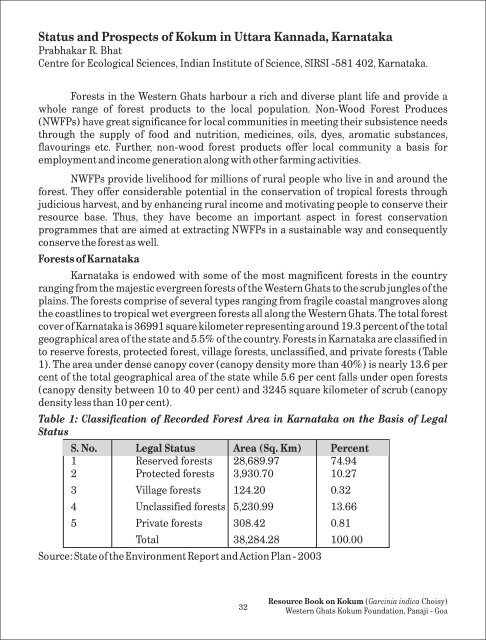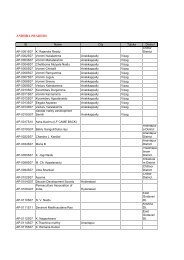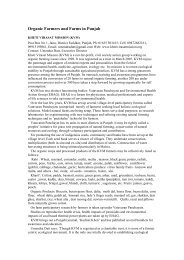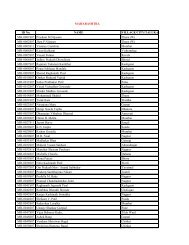Western Ghats Kokum Foundation - Organic Farming Association of ...
Western Ghats Kokum Foundation - Organic Farming Association of ...
Western Ghats Kokum Foundation - Organic Farming Association of ...
Create successful ePaper yourself
Turn your PDF publications into a flip-book with our unique Google optimized e-Paper software.
Status and Prospects <strong>of</strong> <strong>Kokum</strong> in Uttara Kannada, Karnataka<br />
Prabhakar R. Bhat<br />
Centre for Ecological Sciences, Indian Institute <strong>of</strong> Science, SIRSI -581 402, Karnataka.<br />
Forests in the <strong>Western</strong> <strong>Ghats</strong> harbour a rich and diverse plant life and provide a<br />
whole range <strong>of</strong> forest products to the local population. Non-Wood Forest Produces<br />
(NWFPs) have great significance for local communities in meeting their subsistence needs<br />
through the supply <strong>of</strong> food and nutrition, medicines, oils, dyes, aromatic substances,<br />
flavourings etc. Further, non-wood forest products <strong>of</strong>fer local community a basis for<br />
employment and income generation along with other farming activities.<br />
NWFPs provide livelihood for millions <strong>of</strong> rural people who live in and around the<br />
forest. They <strong>of</strong>fer considerable potential in the conservation <strong>of</strong> tropical forests through<br />
judicious harvest, and by enhancing rural income and motivating people to conserve their<br />
resource base. Thus, they have become an important aspect in forest conservation<br />
programmes that are aimed at extracting NWFPs in a sustainable way and consequently<br />
conserve the forest as well.<br />
Forests <strong>of</strong> Karnataka<br />
Karnataka is endowed with some <strong>of</strong> the most magnificent forests in the country<br />
ranging from the majestic evergreen forests <strong>of</strong> the <strong>Western</strong> <strong>Ghats</strong> to the scrub jungles <strong>of</strong> the<br />
plains. The forests comprise <strong>of</strong> several types ranging from fragile coastal mangroves along<br />
the coastlines to tropical wet evergreen forests all along the <strong>Western</strong> <strong>Ghats</strong>. The total forest<br />
cover <strong>of</strong> Karnataka is 36991 square kilometer representing around 19.3 percent <strong>of</strong> the total<br />
geographical area <strong>of</strong> the state and 5.5% <strong>of</strong> the country. Forests in Karnataka are classified in<br />
to reserve forests, protected forest, village forests, unclassified, and private forests (Table<br />
1). The area under dense canopy cover (canopy density more than 40%) is nearly 13.6 per<br />
cent <strong>of</strong> the total geographical area <strong>of</strong> the state while 5.6 per cent falls under open forests<br />
(canopy density between 10 to 40 per cent) and 3245 square kilometer <strong>of</strong> scrub (canopy<br />
density less than 10 per cent).<br />
Table 1: Classification <strong>of</strong> Recorded Forest Area in Karnataka on the Basis <strong>of</strong> Legal<br />
Status<br />
S. No. Legal Status Area (Sq. Km) Percent<br />
1 Reserved forests 28,689.97 74.94<br />
2 Protected forests 3,930.70 10.27<br />
3 Village forests 124.20 0.32<br />
4 Unclassified forests 5,230.99 13.66<br />
5 Private forests 308.42 0.81<br />
Total 38,284.28 100.00<br />
Source: State <strong>of</strong> the Environment Report and Action Plan - 2003<br />
32<br />
Resource Book on <strong>Kokum</strong> (Garcinia indica Choisy)<br />
<strong>Western</strong> <strong>Ghats</strong> <strong>Kokum</strong> <strong>Foundation</strong>, Panaji - Goa





